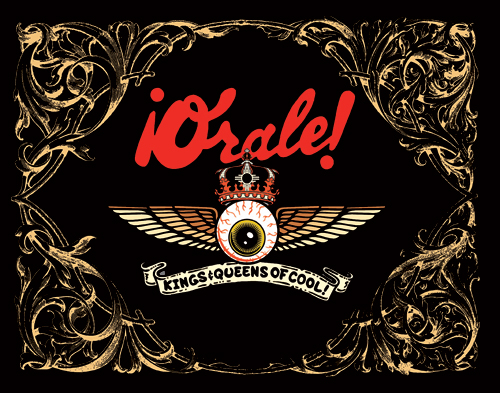|
| |
�Orale! Kings and Queens of Cool - Art Exhibits

Orale! Kings and Queens of Cool is a four-part exhibition focusing on the Post-Pop or Lowbrow art movement that grew out of West Coast surfer, street and car cultures. On view in the Harwood Museum of Art's Mandelman-Ribak Gallery, Lowbrow Insurgence: The Rise of Post-Pop Art will bring together the work of internationally recognized artists including Robert Williams, Gary Baseman, Ron English and R. Crumb.
Concentrating on painting and sculpture, �ORALE! Kings and Queens of Cool is comprised of four unique exhibitions addressing several basic themes: Post-Pop, pinstriping, tattoo, graffiti, and a small sampling of original rock poster art. Over 150 works by approximately seventy artists will demonstrate the transformation and integration of what once was considered �low� art into �high art.� Indeed, this exhibition seeks to refute the previous terminology of �lowbrow� and introduce what is common to a younger generation as �Post-Pop.�
The work introduced in this series of exhibitions seeks to broaden visual literacy and understanding of the imagery of consumer society - mass communication circling the heads of younger artists. The exhibition is also meant to unite and applaud the current culture of Northern New Mexico and its relationship to current national culture.
In the context of art history, it makes sense that this group of artists has met with conflict. Sometimes you would not choose to be remembered for your own judgment calls. Louis Vauxcelles (1 January 1870,Paris � 1943, Paris), an influential art critic of his time, was one of the first to comment on the work of �les fauves� or �wild beasts,� stating:
A movement I consider dangerous (despite the great sympathy I have for its perpetrators) is taking shape among a small clan of youngsters. A chapel has been established, two haughty priests officiating. MM Derain and Matisse; a few dozen innocent catechumens have received their baptism. Their dogma amounts to a wavering schematics that proscribes modeling and volumes in the name of I-don't-know- what pictorial abstraction. This new religion hardly appeals to me. I don't believe in this Renaissance... (VGil Blas, Vauxcelles, 20 March 1907)
As the past has taught us, virtually every new form of creative endeavor is, in its nascence, an intolerable offense to the cognoscenti. Similar examples are historically recorded about the Pre-Raphaelite Brotherhood, Dada, Expressionism, Surrealism and so on. When does the birth of a new movement become a rock solid, historically sound monument to the human spirit? Is it when its members are picked up by prestigious galleries and collectors? Is it when television and theatrical documentaries are made? Is it when major international museums collect their work? I would say so. Is it then the responsibility of an educational institution to exhibit and teach the community and students about the new forms rising around us? I would say so.
We can use Robert Williams, born in 1943 in Albuquerque, NM, as an answer to the questions stated above. Williams has accomplished everything referenced above. In the historic lineage of �lowbrow,� Williams would be the prot�g� of Von Dutch and Ed �Big Daddy� Roth. RC Crumb and S. Clay Wilson are his colleagues, Mark Ryden, Marion Peck, Todd Schorr his children. Williams� work filled the cultural space between the museum and comic book convention. "Low brow and alternative art,� stated Williams, �are the crack in the dam and with this leak the art world will never be the same.� In an essay for the Tony Shafrazi Gallery, Carlo McCormick described Williams as �A long shot, a mongrel dark horse that�s been feeding on exhaust-choked psychotropic weeds by the side of the freeway and chasing the fillies when he should have been training, Williams is not only the one to put our money on, he remains the last hope many of us have that spirit and vision will win out over the current pedigreed lot of academic thoroughbreds in the end.�
Several museum exhibitions have previously explored this topic: High and Low: Modern Art and Popular Culture, October 7, 1990 - January 15, 1991, curated by Kirk Varnedoe, Director, Department of Painting and Sculpture, The Museum of Modern Art and Adam Gopnik, Art Critic, The New Yorker. The exhibition then traveled to The Art Institute of Chicago and the Museum of Contemporary Art, Los Angeles. Soon afterwards (1992) Paul Schimmel curated Helter Skelter: L.A. Art in the 1990s at the Los Angeles Museum of Contemporary Art and, in 1998, Pop Surrealism at The Aldrich Contemporary Art Museum. Finally, the Laguna Art Museum presented two related exhibitions: In the Land of Retinal Delights: The Juxtapoz Factor, 2008, and Kustom Kulture: Ed "Big Daddy" Roth, Robert Williams & Others, 1993.
In the future what will the museums, art departments and historians do with this genre? Most likely, study it to understand late 20th and early 21st- century politics and society.
Jina Brenneman, Curator of Exhibitions
The Harwood Museum of Art
238 Ledoux Street in Taos, New Mexico 87571
The Harwood Museum of Art is located on historic Ledoux Street, just south of - and within very easy walking distance of - Taos Plaza.
Phone:575.758.9826
�Orale! Kings and Queens of Cool - Official Website
|
|
|
|




